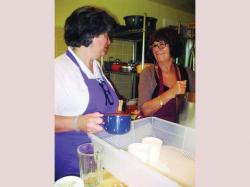Cheese: The Food Americans Find Funny
April 2, 2010 | 2 min to read

Gordon Edgar in his new, hilarious and informative book “Cheesemonger Life on the Wedge” is incredulous that he, an anarchist punk and politico, became a cheese dude at Rainbow Grocery founded in San Francisco in the 1970’s as a workers cooperative.
“Think about it,” Edgar says. “You only need a cheese dude or diva, an expert, if you’re buying something other than mozzarella.”
Although Americans consume 30 pounds of cheese per year ranking them number seventh in the world, and produce over nine billion pounds of cheese per year, we appear hungry for more. Cheese plates are popular on the menus in Yolo County restaurants; make it yourself cheese classes fill up fast; and retail stores stock more cheese than ever.
The staple of any cheese department, Edgar says, (whose cheese blog goes by the name “gordonzola”) is the factory-made, forty-pound commodity block Cheddar.
It’s simple, affordable and feeds a lot of people. Its price is set at the Chicago Mercantile Exchange, which is why it’s called commodity cheese. Ann, who cofounded the Davis Food Co-op as The Peoples Food Conspiracy Buying Club in the early 1970’s in her home, remembers cutting those forty-pound commodity blocks of Jack and Cheddar cheese, which members drove to West Sacramento to get from Tony Ingolia’s Salami and Cheese Company.
The Davis Food Co-op still buys from Tony’s. Cheese Expert Sara Yost says the commodity cheeses are the most popular at the Co-op, but cheese sales overall are up 20% since in the past year. Yost, who’s been cheese diva with the co-op for 10 years, says her customers are demanding more local cheese.
The Davis Food Co-op has a list of eight cow milk and six goat milk cheese producers that are from within a 100 mile radius, and many more within a larger radius. Ask them for it. They will cut to order, sample, and wax prolific on cheese. Be careful though, Yost keeps a diary on funny cheese stories — she may be the next Cheesemonger turned author.
Artisan cheese, the other end of the spectrum from commodity cheeses, was pioneered in the 1970’s on the east coast with Alison Hooper of Vermont Butter and Cheese Company. Her story is told in the book “American Artisanal” by Rebecca Gray, and even Edgar recounts visits with Hooper. The heart of the movement though was in Northern California with Sue Connelly who founded Cowgirl Creamery and Laura Chenel who championed the art of making fine goat cheese in 1979. They really began to connect cheese to the local environment for people in America as it is and has been connected in Europe for centuries.
To read the rest of the story, please go to: The Daily Democrat
